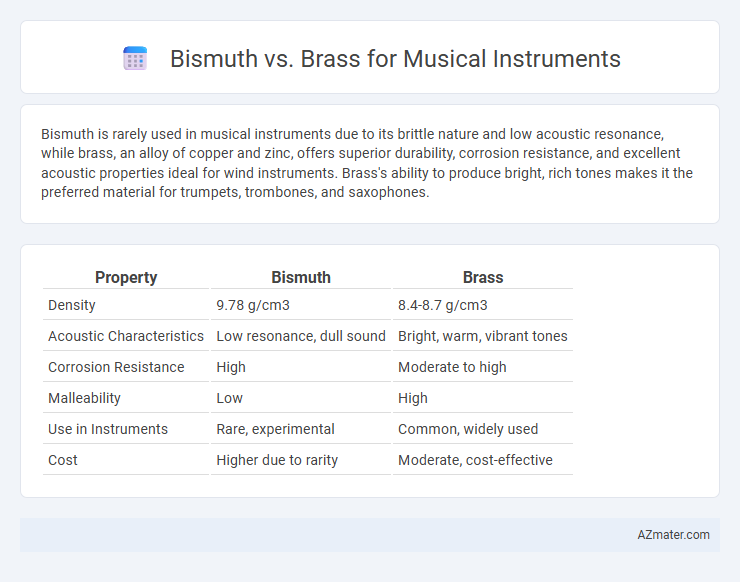Bismuth is rarely used in musical instruments due to its brittle nature and low acoustic resonance, while brass, an alloy of copper and zinc, offers superior durability, corrosion resistance, and excellent acoustic properties ideal for wind instruments. Brass's ability to produce bright, rich tones makes it the preferred material for trumpets, trombones, and saxophones.
Table of Comparison
| Property | Bismuth | Brass |
|---|---|---|
| Density | 9.78 g/cm3 | 8.4-8.7 g/cm3 |
| Acoustic Characteristics | Low resonance, dull sound | Bright, warm, vibrant tones |
| Corrosion Resistance | High | Moderate to high |
| Malleability | Low | High |
| Use in Instruments | Rare, experimental | Common, widely used |
| Cost | Higher due to rarity | Moderate, cost-effective |
Introduction to Bismuth and Brass in Musical Instruments
Bismuth is a brittle, low-toxicity metal rarely used in traditional musical instruments due to its softness and poor acoustic properties, but its unique density and non-toxic characteristics make it a subject of experimental use in certain niche instruments. Brass, an alloy of copper and zinc, is the standard material for many wind instruments like trumpets and trombones, prized for its excellent workability, durability, and superior acoustic resonance. The contrasting physical and acoustic properties of bismuth and brass directly influence their suitability and application in musical instrument design and performance.
Composition and Properties of Bismuth
Bismuth is a brittle, heavy metal with low thermal conductivity and a unique diamagnetic property, often used in alloys to improve machinability and corrosion resistance. Brass, primarily composed of copper and zinc, offers acoustic warmth and durability, making it a preferred material for many brass instruments. Incorporating bismuth into brass alloys can enhance the instrument's precision and tonal clarity by modifying the alloy's density and reducing internal friction.
Composition and Properties of Brass
Brass, an alloy primarily composed of copper and zinc, exhibits excellent machinability, corrosion resistance, and acoustic properties ideal for musical instruments. Its composition varies with zinc content from 5% to 40%, influencing hardness, strength, and tonal quality; higher zinc content enhances brightness and durability, making it preferred for trumpets and horns. The alloy's density and malleability contribute to its resonance and projection, attributes that bismuth, a brittle post-transition metal with limited ductility and acoustic performance, cannot match for instrument manufacturing.
Acoustic Characteristics: Bismuth vs Brass
Bismuth exhibits lower acoustic resonance and dampens sound waves more than brass, resulting in a softer, less vibrant tone. Brass, an alloy of copper and zinc, is prized for its bright, rich sound with excellent projection and sustain, making it ideal for wind and brass instruments. The higher density and stiffness of brass contribute to its superior acoustic clarity and harmonic complexity compared to bismuth.
Durability and Maintenance of Bismuth and Brass Instruments
Bismuth instruments generally exhibit lower durability compared to brass, as bismuth is a softer, more brittle metal prone to cracking under impact or stress. Brass instruments, composed primarily of copper and zinc, have superior resistance to wear and deformation, making them more suitable for frequent use and handling. Maintenance for bismuth instruments can be more challenging due to their susceptibility to corrosion and damage during cleaning, whereas brass instruments benefit from established cleaning routines that preserve their longevity and tonal quality.
Workability and Manufacturing Challenges
Bismuth, known for its brittleness and low ductility, poses significant challenges in workability when used for musical instruments, often requiring specialized casting techniques to avoid cracking. Brass, an alloy of copper and zinc, offers superior malleability and ease of machining, making it the preferred material for crafting wind instruments and components with intricate shapes. Manufacturing with brass benefits from established forging, stamping, and soldering processes, whereas bismuth's fragility limits its practical application in instrument production.
Cost and Availability Comparison
Bismuth is significantly more expensive and less available than brass, making brass the preferred material for musical instruments regarding cost efficiency and accessibility. Brass, an alloy primarily of copper and zinc, is widely produced and readily sourced, contributing to its affordability and common use in trumpets, trombones, and saxophones. Bismuth's rarity and higher raw material cost limit its practical application in instrument manufacturing despite its unique acoustic properties.
Aesthetics and Visual Appeal
Brass, traditionally favored for musical instruments, offers a warm, golden hue that enhances the instrument's classic and luxurious appearance, appealing to both musicians and audiences alike. Bismuth provides a unique, iridescent color spectrum with shimmering blues, purples, and greens, delivering a visually striking and modern aesthetic rarely seen in instruments. The choice between bismuth and brass impacts the instrument's visual identity, with brass conveying tradition and bismuth highlighting innovation and artistic individuality.
Environmental Impact and Sustainability
Bismuth is a non-toxic, biodegradable metal with low environmental impact, making it a sustainable choice for musical instruments compared to brass, which contains copper and zinc and involves more energy-intensive mining and refining processes. Brass production contributes to significant metal pollution and resource depletion, whereas bismuth is often recovered as a byproduct of other mining operations, reducing additional environmental strain. Choosing bismuth can enhance eco-friendly instrument manufacturing by minimizing toxic emissions and promoting resource efficiency.
Conclusion: Choosing Between Bismuth and Brass
Bismuth offers unique acoustic properties such as enhanced sound clarity and resistance to corrosion, making it suitable for specialized musical instruments. Brass remains the standard material due to its excellent tonal warmth, durability, and ease of machining, which is preferred by most instrument makers. Choosing between bismuth and brass depends on the desired sound characteristics and application, with brass favored for traditional uses and bismuth for innovative tonal experimentation.

Infographic: Bismuth vs Brass for Musical instrument
 azmater.com
azmater.com